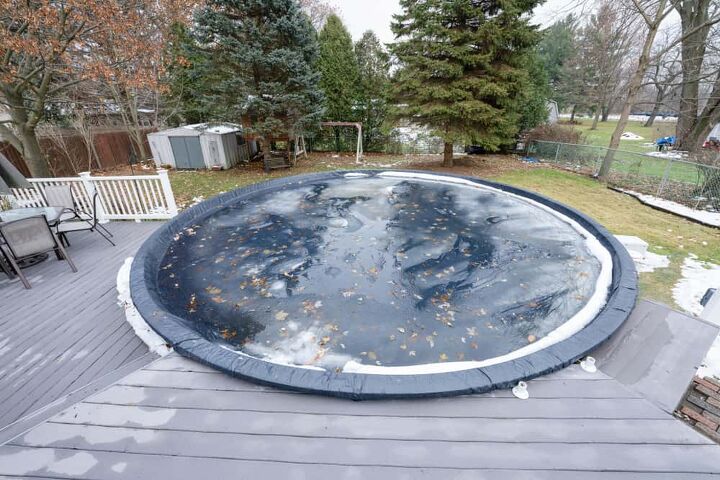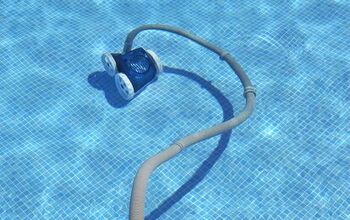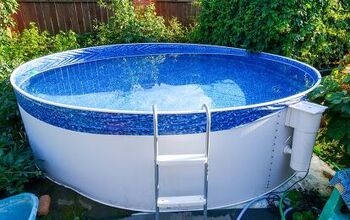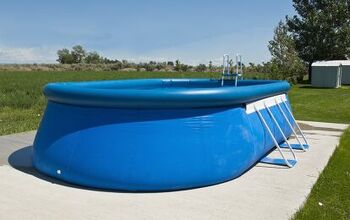How To Winterize An Above Ground Pool

Your pool served you well this summer. Now, it’s time to take several steps to prepare it for the offseason. Winterizing your pool isn’t hard. There are a few steps to follow to get the job done right. Next year, when the scorching hot weather returns, you’ll be glad you did.
Winterize your above ground pool by securing three things: water chemistry, pool plumbing, and structural integrity. If you get each of these things right, you shouldn’t have any issues. Non-winterized or improperly winterized pools can be destroyed in the cold weather.
To winterize an above ground pool, begin by cleaning out your pool and removing any accessories. Check the alkalinity, pH, phosphate, and calcium levels to see if your pool is safe. Next, clear the skimmer and fully drain the pump. Finish by using pool pillows and covers to winterize your pool.
In this article, we are going to explain the easiest way to winterize your above ground pool. We will break down the core steps so you can be confident your pool will survive the winter.
Let’s begin.
Do You a Need Pool, Spa, or Hot Tub Contractor?
Get free, zero-commitment quotes from pro contractors near you.

When Should You Winterize Your Above Ground Pool?
Generally, when you’ve finished with your pool for the season, it’s time to winterize it. However, if freezing conditions are still far off, you can allow your pump and skimmer to function for a bit longer. Don’t let your pool run indefinitely. And don’t wait until the last minute.
Also, before you begin the technical aspects of winterization, clean your pool thoroughly. Vacuum, scrub and skim until it sparkles. A good cleaning will assure that nothing organic festers in your pool. You don’t want to find a monster hidden beneath your tarp next spring.
Water Chemistry
Nobody likes swimming in a pool filled with green slime. That’s why your water chemistry is vital to proper winterization. You want to keep away all the algae and bacteria. Your pump and filter will be turned off during the winter, so you must make sure your pool water can fend for itself.
Here’s what you need to know about your pool’s water chemistry:
- Alkalinity
- pH
- Phosphate
- Calcium
Use the chart below to keep track of proper chemical levels.
| Pool Chemical | Normal Level |
| Alkalinity | 100 – 150 ppm |
| pH | 7.4-7.6 |
| Chlorine | 1.5 – 3 ppm |
| Calcium | 200 – 400 ppm |
Alkalinity
Your pool’s alkalinity will directly affect the pH. You want to keep your alkalinity somewhere between 100 and 150 ppm (parts per million). For the winter months, keep your alkalinity on the higher side of average.
Adjust alkalinity before you adjust your pH. This is because one plays off the other. We will explain the pH in a moment. Here’s the basic rule: alkalinity that is too high will cause your pool’s pH to drift up, but if it’s too low, your pool’s pH will become erratic.
After testing your pool’s alkalinity with a test kit, you can raise it by adding an increaser – like Sodium Bicarbonate – or you can decrease the alkalinity by adding muriatic acid.
pH
Your pH should be between 7.4 and 7.6. What do these numbers mean? A pH below 7.35 is considered acidic. Acidic water is harsh on the skin. Basic water, which is pH greater than 7.35, is safer for swimmers and is more natural (the human body is slightly basic).
However, if your water becomes too basic, it will damage pool liners and metal structures. Like alkalinity, you should keep your pH on the higher side of average. You can raise or lower your pH with additives made specifically for your pool.
Phosphate
Elevated phosphate levels can cause more algae growth. However, it typically takes a long time for phosphate to reach these levels. And, if you’re keeping your pool correctly chlorinated, clean, and occasionally shocking it, you shouldn’t worry about phosphate.
Chemicals to decrease phosphate levels can be harmful in themselves. If you have a severe algae problem, phosphates may be a factor. If not, don’t worry about it.
Calcium
Keep calcium levels between 200 and 400 ppm. The calcium levels in your pool are critical. Here’s why.
If calcium levels drop too low, then your pool will strip calcium from other places. Your tiles, plasters, anywhere it can get some calcium. The result is an eroded and irreparable pool.
But, if your calcium levels become too high, you will start to see scaling. You’ll see a coating begin to form on areas the water contacts. This yellow crusting is an eyesore. Be sure to check and balance the calcium levels in your pool.
If you have severe crusting or corrosion in your pool, see our article on how much it costs to replaster a pool.
Pool Shock and Algaecide
After you’ve adjusted the previous chemicals, it’s time to give your pool a final shock before the winter. The type of shock you use will depend on your pool size and the sanitizer you’re using. A high dose of chlorine is a standard pool shock, and it will do a good job scaring off any unwanted algae and bacteria.
If you’ve had troubles will algae in the past, you might try adding some algaecide to your pool. This is optional based on your circumstances.
Chlorine
Be sure your chlorine level is between 1.5 and 3 ppm. After you’ve cleaned out your pool and balanced all the chemicals, let your pool pump run for a full cycle.
Plumbing
Great job, you’ve addressed your pool’s water chemistry. Now for the fun part. Your above ground pool has several components that need attention. If you live in an area with temperatures anywhere close to freezing, you must drain all parts of the plumbing system. Here’s a list to stay on track:
- Skimmer
- Pump and pipes
- Return tubing
- Filter
Skimmer
Your skimmer catches large debris, like leaves and sticks, to remove them from your pool. Be sure to clear out the basket that catches the debris and remove the pipe from the skimmer to the pump. This piping needs to be drained.
You don’t want your skimmer to crack during the winter, so there are several things you can do. First, you could drain the water below the level of the skimmer. This removes the possibility of water freezing inside the skimmer and cracking it. Second, you could purchase a skimmer cover to keep water out in the cold weather.
Note: you should never completely drain your above ground pool. The water acts as a barrier to protect your liner from damage. Also, some above ground pools need water to maintain their structure. Removing all water could cause damage.
Pump
After clearing your skimmer, you now need to protect your pump. You’ll need to drain it. There are usually one or two drain plugs located on your pump. Unscrew these plugs and allow all water to clear.
Keep an eye out for any washers or o-rings that fall out when you remove plugs or water lines. These little guys are important. If it gets especially cold in your area, you want to oil the o-rings and bring them inside for the winter. This ensures you won’t have any leaky connections next year.
We recommended, if possible, to bring your whole pump inside during the cold weather. This ensures it will be safe and ready for another season of fun in the pool.
Filter
Your filter will also have drain plugs. Remove these and allow the water to clear. This is similar to the pump. Many filters will have settings. If yours does, set it to winter mode. If you can, bring the filter inside for the winter. This is especially true for the sand filters, where it can be difficult to drain fully. ‘
Sand filters are heavy. If you’re unable to bring it inside, then cover it, and leave the drain plugs off.
With the plethora of filters used, it’s wise to check with the manufacturer to be certain there are no other steps you need to take.
Return Piping and Chlorinator
If you have a chlorinator, follow the same steps and clear it of water. Then bring it indoors. Don’t forget about the return piping either; this needs to be removed and cleared.
Anything containing water needs to be dealt with, as there is always the risk of freezing and cracking. Pool equipment is expensive and tedious to replace. You’ll be glad you took extra care (and you’ll kick yourself if you don’t).
Protect Pool’s Structure
Pool pillow
In areas where your pool water is likely to freeze, a pool pillow can be used to prevent the frozen water from damaging the pool’s structure.
When water freezes, it expands. In your pool, unless it has somewhere else to go, it will expand out. This can cause cracks and leaks in your walls. That’s where the pool pillow comes in. It gives the water somewhere else to go. Here’s how it works.
The pillow is large, like the size of a large cushion. You inflate it and place it in the middle of your pool underneath the cover. Secure it with cords or velcro and it will absorb the ice’s pressure when it freezes. This is protecting the integrity of your structure.
When using the pillow, only inflate it to about 50 or 60 percent capacity. This ensures that it won’t pop when the ice begins to exert pressure.
Pool Cover
Finally, after clearing all accessories, balancing the chemistry, and placing your pool pillow, you’re ready to cover it. Place the cover and secure tightly on all sides. Ensure it won’t blow away by attaching jugs of water to the ringlets. Also, take some time to thread a wire through the edges of your tarp and cinch it tight.
For more questions about pool covers, see our article about running a pool pump with a solar cover in place.
Do You a Need Pool, Spa, or Hot Tub Contractor?
Get free, zero-commitment quotes from pro contractors near you.

Related Questions
Does an Above Ground Pool Freeze Solid?
If you are in an area with freezing temperatures, then yes. Be sure to follow the winterization steps in the article above, and don’t forget about your pool pillow.
Can I Leave My Above Ground Pool Uncovered in the Winter?
Don’t leave your above ground pool uncovered. This will make it susceptible to sticks and leaves. Also, exposure to the elements will mess with your pool chemistry. If you leave it exposed, you will have a mess come spring.
How Far Should You Drain an Above Ground Pool?
Just below the skimmer line, unless you are using a skimmer cover – in this case, you don’t need to drain the pool at all. Only Intex pools should be completely drained in freezing conditions.

Gideon is a writer and hobby woodworker. He enjoys working on projects small and large-everything from crafting boxes and benches, to replacing carpet and landscaping a yard.
More by Gideon Zielinski



























